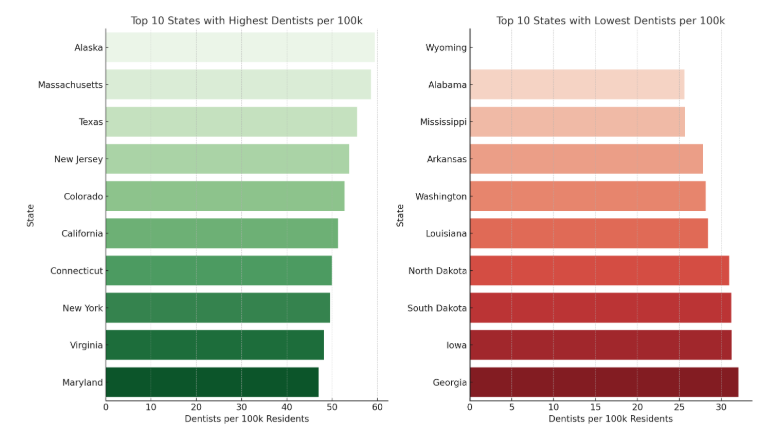Access to dental care is a crucial component of overall health, yet it varies significantly across the United States.
Certain states boast a high number of dentists per capita, ensuring residents have better access to oral health care, while others struggle with low dentist availability, creating barriers to essential services.
This article dives into the top 10 states with the highest and lowest numbers of dentists per 100,000 residents, offering insights into the disparities in dental care access across the nation.
Key Takeaways
- Wide Disparity in Dentist Availability: States like Alaska and Massachusetts lead with the highest number of dentists per capita, while states like Georgia and Iowa lag far behind.
- Regional Trends: Many of the top-performing states are in the Northeast and West, whereas lower-performing states are often in the South and Midwest.
- Policy Implications: Addressing dentist shortages in underserved areas is critical for improving national oral health standards.
Methodology
This study, done by Humble Memorial Dental, a leading dentist in Humble TX, uses the most recent data from LinkedIn on the number of dentists per 100,000 residents for all 50 states.
The states are ranked to identify the top 10 with the highest and lowest dentist-to-population ratios. These findings are visualized to highlight the stark differences in access to dental care.
Top 10 States with the Highest Dentists per Capita
The following states provide the best access to dental care, as measured by the number of dentists per 100,000 residents:
One of the easiest ways to keep your smile healthy for life.
Alaska: With 59.35 dentists per 100,000 residents, Alaska leads the nation. Its robust healthcare infrastructure ensures better access for its residents despite its vast geography.
Massachusetts: A hub for healthcare excellence, Massachusetts has 58.56 dentists per 100,000 residents.
Texas: Known for its large population, Texas ensures accessibility with 55.51 dentists per 100,000 residents.
New Jersey: With 53.82 dentists per 100,000 residents, New Jersey maintains a strong dental network.
Colorado: A state focused on wellness, Colorado boasts 52.75 dentists per 100,000 residents.
California: The state has 51.33 dentists per 100,000 residents, reflective of its emphasis on healthcare access.
Connecticut: With 49.93 dentists per 100,000 residents, Connecticut’s healthcare system remains strong.
New York: New York offers 49.56 dentists per 100,000 residents, catering to its large and diverse population.
Virginia: The state provides 48.18 dentists per 100,000 residents, ensuring quality care.
Top 10 States with the Lowest Dentists per Capita

On the other end of the spectrum, these states struggle with low dentist-to-population ratios:
- Georgia: With only 25.62 dentists per 100,000 residents, Georgia faces significant challenges in dental care access.
- Iowa: The state has just 31.20 dentists per 100,000 residents, reflecting limited resources.
- South Dakota: At 32.18 dentists per 100,000 residents, South Dakota’s rural nature contributes to its ranking.
- North Dakota: Similarly, North Dakota has 32.34 dentists per 100,000 residents.
- Louisiana: With 32.24 dentists per 100,000 residents, the state faces barriers to care.
- Washington: Despite its urban centers, Washington has only 35.55 dentists per 100,000 residents.
- Arkansas: Arkansas has a ratio of 36.30 dentists per 100,000 residents.
- Mississippi: With 35.64 dentists per 100,000 residents, Mississippi continues to struggle with healthcare disparities.
- Alabama: Alabama reports 36.49 dentists per 100,000 residents.
- Wyoming: With 36.63 dentists per 100,000 residents, Wyoming’s sparse population contributes to its challenges.
Conclusion
The stark differences in dentist availability across states reveal critical gaps in healthcare access.
While states like Alaska and Massachusetts excel in providing ample dental care resources, states such as Georgia and Iowa highlight the urgent need for intervention.
Addressing these disparities will require targeted policies, incentives for dental professionals to serve underserved areas, and investments in healthcare infrastructure.
By bridging these gaps, we can ensure equitable access to dental care for all Americans. Interested in more dental statistics and facts? Check out these oral health statistics.


